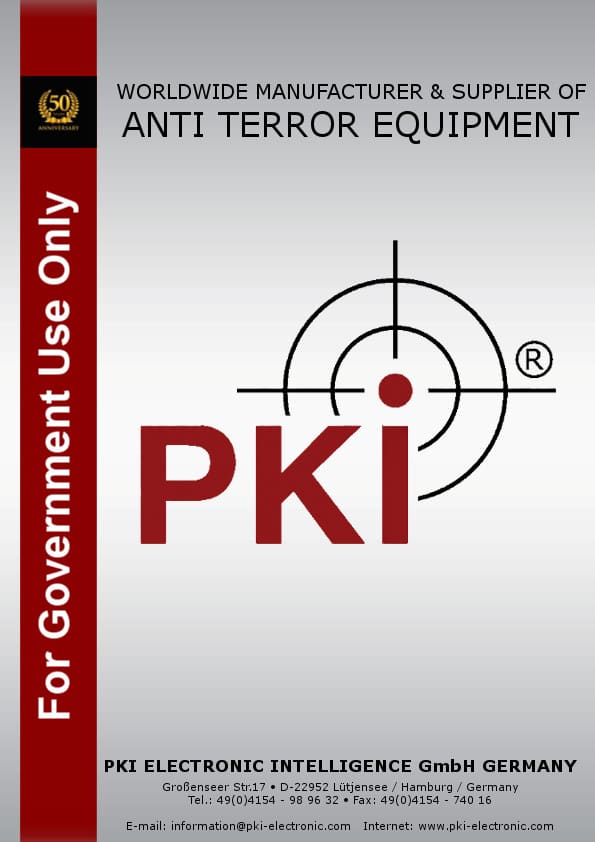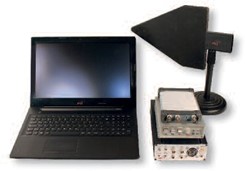The spectrum analyzing technology used in the PKI 4000 Counter Surveillance Sweeping System provides the professional level of sweeping. Giving full information about the radio frequencies being used in the area to the operator practically without necessity to move the equipment within the territory. The detection is comparative to the conventional RF detectors, so the sweeping procedure can be performed quickly and covertly, room by room.
This system can be placed both inside the room being checked and in an adjacent premise to provide secrecy of operation. 2-antenna analysis used in PKI 4000 allows you to detect RF bugging devices not depending on the type of modulation and encryption. Its working principle is based on the nature of radio waves to decrease power proportionally to the distance to the source. Signal on the close antenna will be stronger than the one received in the remote antenna. Such PKI system quickly selects the transmissions which originate from the inside of the premise.
The system has a built-in high-quality antenna switcher. After the sweeping the operator can perform the location procedure and find the exact location of the bug. In addition to the RF analysis PKI 4000 has the possibility to check the wire communications. Infrared range and electromagnetic range for presence of illegal signals. For this aim the system includes a low-frequency converter. The PKI 4000 system and its software have a simple intuitive interface and do not demand special knowledge from the operator. Typically the operation is performed in 3 stages:
Advantages of PKI 4000 Counter Surveillance Sweeping System:
1) Placement of the antenna or probes;
2) Pressing the corresponding operation button;
3) Watching the results.
At the same time professionals will find many highgrade possibilities and settings which can be useful for deeper learning of RF environment at a further usage.
| Features |
|---|
| Quickly and reliably detects eavesdropping devices which use the RF waves, wires and infrared beams for transmission of information from the premises |
| Types of detected bugs: VHF / UHF radio microphones, GSM/3G bugs (GSM baby), digitally encrypted radio microphones, telephone transmitters, AC/telephone line/Ethernet currier transmitters, hidden video cameras with transmitters, microphones with transmission via the infrared beams, hidden electronic devices in objects |
| 2-antenna analysis provides quick selection of the RF signals originating from the checked rooms not depending on the modulation type |
| Measurement are accomplished with the help of the modern digital receiver, providing spectrum analysing possibilities with the scan rate of 50 MHz per second at 12.5 kHz resolution |
| Detects intermittent (non-constant) signals with the help of the Sonogram function |
| Wide frequency range covered: 5 kHz - 4400 MHz (ver. 4G) and 5 kHz – 12400 MHz (ver. 12G) |
| Built-in low-frequency convertor provides features for inspection of the wires, electro-magnetic range and the infra-red range |
| Working modes: RF sweep, Microwave check, AC check, TLF check (telephone/low-voltage wire), IR check (infrared optical range), MLP check (electromagnetic probe), Detector-Locate |
| Detector-Locate mode allows the operator to find the physical location of the transmitter |
| Digital communication sources (GSM, Wi-Fi, Bluetooth, 3G, LTD, Wi-Max, etc.) can be inspected and located |
| Automatic data logging provides possibility to accumulate signal’s history during the searches |
| Wide set of graphical elements: Spectrum (current, max, min, remote antenna, threshold, etc); Sonogram; IQ constellation; Oscilloscope; FFT-spectrum |
| FM/AM demodulation with selectable bandwidth |
| Analysis of the modulation in the IQ constellation window |
| Database stored in Microsoft Access format |
| Recording of demodulated audio |
| High quality RF antennas and VLF-probes included in the supplied set: 2 omnidirectional ODA-4 antennas, 1 microwave MWA-6 antenna, 1 microwave MWA-12 antenna (for version 12G only), 1 infrared IR-LINE probe, 1 electromagnetic MLP-LINE probe, 1 110/220V probe AC-LINE, 1 telephone line/low voltage probe |
| Specifications | |
|---|---|
| RF frequency range | 4G: 50 kHz - 4400 MHz / 12G: 50 kHz - 12400 MHz |
| Scan rate | 4G: 75 MHz per second / 12G: 50 MHz per second |
| Resolution | 12,5 kHz |
| Displayed dynamic range | -90 dBm 50 -10 dBm |
| Demodulation | FM / AM |
| Demodulation bandwidth | 240/120/60/30/15 kHz |
| Audio bandwidth (VBW) | Adjustable 22kHz - 1 kHz |
| Attenuator | PRE-AMP, 0dB, 5dB, 10dB and 15dB |
| Inputs | 3 antenna inputs, 4 probe inputs |
| Selectable scan (manual mode) | 50 MHz, 25 MHz, 10 MHz, 5 MHz and 2 MHz |
| Detection of pulse transmissions | Yes, pulse mode on |
| Observe mode | Frequency domain (spectrum); time domain (demodulation) |
| Graphic windows | Spectrum of wide range (selectable span between 1,5 to 3000 MHz), signal’s spectrum, IQ constellation, oscilloscope, FFT-spectrum |
| Real-time I/Q data streaming | At 240 kHz bandwidth |
| Compatibility | Windows XP, Windows Vista, Windows7, Windows8 |
| Power source | 220 (110) V |


